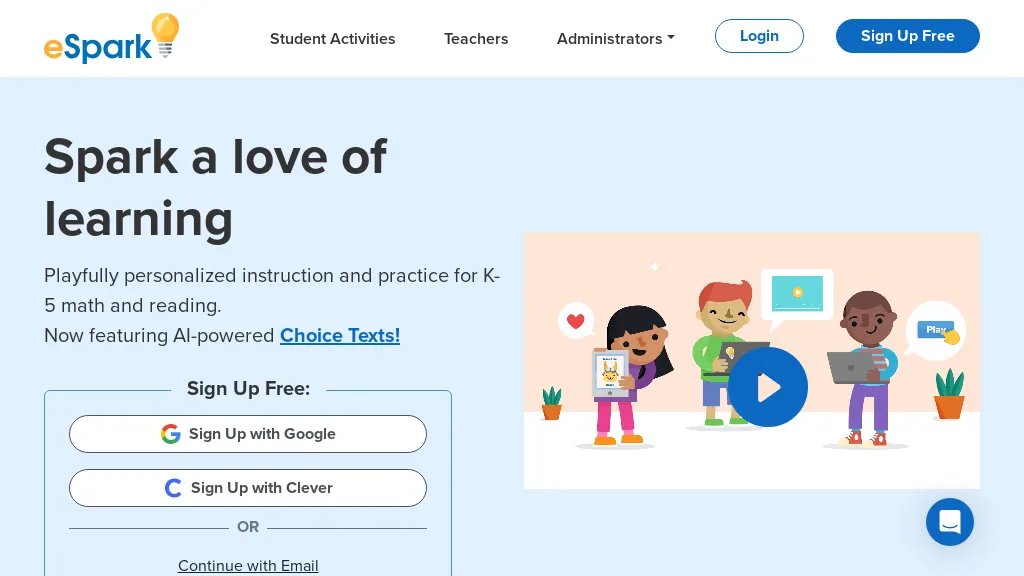What is eSpark?
eSpark is an AI-powered education tool that delivers individualized instruction and practice in math and reading to students in grades K-5. Engineered to a research-based model of curriculum standards, eSpark is designed to support teachers, administrators, and students with its suite of interactive activities tailored to meet individual needs.
What really differentiates eSpark is its option texts that students can use to explore on their own. The topics it covers include counting, sight words, syllables, addition, subtraction, division, multiplication, and many more. With over 1 million students already using the tool, it has become quite effective for the modern classroom.
Key Features & Benefits of eSpark
eSpark is a top-rated system integrated with multiple features that make it very favorable for all teachers and students alike to use.
-
Personalized Instruction:
Tailor-made learning experiences for each learner based on their requirement. -
Interactive Math and Reading Activities:
Engage learners through a number of enjoyable and instructive activities that establish learning gaps. -
Real-time data and insights:
Enable teaching what students are not learning. -
Small Group Lessons and Activities:
A group-based process for differentiated instruction. -
Targeted Intervention:
This provides the evidenced-based intervention the students need when they are not demonstrating mastery of the skills.
These are characteristics that in a way save much time for the teachers, engage the students much better, and improve learning outcomes—making eSpark a recommended tool in any kind of educational setting.
Use Cases and Applications of eSpark
eSpark has many different uses in education, including:
-
Student Engagement:
Students get to engage in interactive activities that make learning fun and effective. -
Progress Monitoring:
The teacher is allowed to monitor students’ or a class’s progress, trending for patterns or areas for improvement. -
Provisioning of Evidence-Based Interventions:
From data-driven insights, administrators and teachers can use this to provide more targeted support to students in need.
eSpark shows key benefits at the elementary level where kids’ classroom experience is personalized and interactive learning allows them to be more confident and academically performing.
How to Use eSpark
Using eSpark is easy and hassle-free:
-
Setup:
Teachers can easily integrate eSpark into their existing classroom setup with roster and assessment integrations. -
Guided Lessons:
Introduce new concepts with guided lessons and instructional videos. -
Track Progress:
Monitor real-time data to see student progress and infer learning gaps. -
Target Interventions:
Detailed reports and individually mailed email updates will deliver targeted interventions.
Best practices are to review regularly from the data provided by eSpark, adjusting instructional strategies so that all students are showing adequate progress.
How eSpark Works
eSpark delivers a highly personalized learning experience through artificial intelligence. Complex algorithms maintain the platform’s content levels depending on student performance. These analyses are used to create focused, ongoing educational content that answers the needs of each particular student.
The workflow will contain:
-
Collection:
Student performance information is collected through interactive activities. -
Analysis:
AI analysis of data identifying areas where students need improvement. - It provides personalized learning activities based on the analysis. This cyclic process supports continuous improvement and personalized support of each student.
eSpark Pros and Cons
As a tool, eSpark comes with its share of pros and probable cons:
Pros:
- Highly personalized learning experiences
- Engaging, interactive content
- Real-time data and insights
- Supports differentiated instruction
Cons:
- Steep learning curve for teachers who are new to AI tools
- Requires internet access and technology.
Feedback from users has been overwhelmingly positive, with many teachers noting significant improvements in student engagement and learning outcomes.
Conclusion on eSpark
eSpark is one such influential AI-powered education tool that provides K-5 students with personalized learning opportunities in an interactive manner. Its research-based curriculum, real-time data insights, and targeted interventions help teachers and administrators very effectively in improving the learning outcomes of students.
With the benefits it offers and the very encouraging feedback from its users, I would highly recommend eSpark for elementary school settings. Leaves much room for future development in capability and usability.
eSpark FAQs
Q: How do I implement eSpark in my classroom?
A: eSpark has roster and assessment integrations, which make it very easy to implement into your current classroom set-up.
Q: What kind of activities does eSpark have?
A: eSpark offers many engaging activities on mathematics and reading like counting, sight words, addition, subtraction, multiplication, and many more.
Q: How does eSpark help to recognize learning gaps?
A: By analyzing student performance data in real-time using AI, insights are provided to the teacher to identify and address learning gaps effectively.
Q: Is the support available for teachers using eSpark?
A: Yes, it does provide resources, feedback, and support to help teachers maximize its potential in classrooms.










